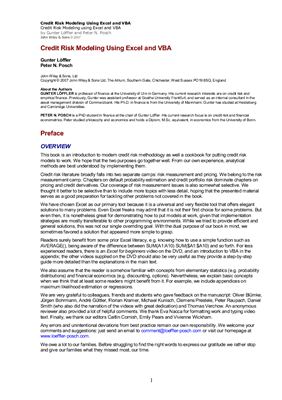This book is an introduction to mode credit risk methodology as
well a cookbook for putting credit risk models to work. We hope
that the two purposes go together well. From our own experience,
analytical methods are best understood by implementing them.
Credit risk literature broadly falls into two separate camps: risk measurement and pricing. We belong to the risk measurement camp. Chapters on default probability estimation and credit portfolio risk dominate chapters on pricing and credit derivatives. Our coverage of risk measurement issues is also somewhat selective. We thought it better to be selective than to include more topics with less detail, hoping that the presented material serves as a good preparation for tackling other problems not covered in the book.
We have chosen Excel as our primary tool because it is a universal and very flexible tool that offers elegant solutions to many problems. Even Excel freaks may admit that it is not their first choice for some problems. But even then, it is nonetheless great for demonstrating how to put models at work, given that implementation strategies are mostly transferable to other programming environments. While we tried to provide efficient and general solutions, this was not our single overriding goal. With the dual purpose of our book in mind, we sometimes favored a solution that appeared more simple to grasp.
Credit risk literature broadly falls into two separate camps: risk measurement and pricing. We belong to the risk measurement camp. Chapters on default probability estimation and credit portfolio risk dominate chapters on pricing and credit derivatives. Our coverage of risk measurement issues is also somewhat selective. We thought it better to be selective than to include more topics with less detail, hoping that the presented material serves as a good preparation for tackling other problems not covered in the book.
We have chosen Excel as our primary tool because it is a universal and very flexible tool that offers elegant solutions to many problems. Even Excel freaks may admit that it is not their first choice for some problems. But even then, it is nonetheless great for demonstrating how to put models at work, given that implementation strategies are mostly transferable to other programming environments. While we tried to provide efficient and general solutions, this was not our single overriding goal. With the dual purpose of our book in mind, we sometimes favored a solution that appeared more simple to grasp.

